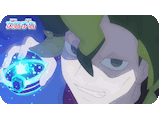



Main
Old Updates Archive
Links
 |
Lists |
List of Pokémon
Pokémon World Atlas
List of Techniques
List
of Items
List of TV Episodes
 |
Guides |
Episode
Comparisons
Movies
& Specials Guide
CD Guide
DVD Guide
Voice
Actors Guide
Lyrics Archive
Manga Guide
Video Games
 |
Miscellaneous |
Humor
Pokémon Bashing
Features
Rants
The items listed below are all differences between the Japanese original and the English dub that are present in just about every single episode the weekly TV series. The edits listed on this page only apply to the main TV series as the movies, specials, OVAs, web series, etc. are often edited under completely different standards.
| Eyecatches | Post-Show Music Videos | Ending Credits | Post-Show Segments | Next Episode Previews |
| Show Title |
The Japanese TV
show, video
games, and most other products related to the franchise in Japan go
under the title Pocket Monsters.
In America, the TV show, video games, and other products all go under
the title Pokémon.
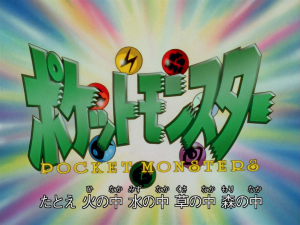 |
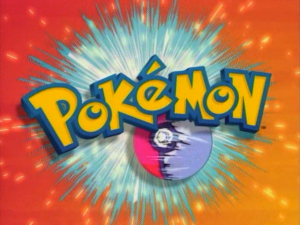 |
| The logo for the Japanese version of the show, taken from "Mezase Pokemon Master." | The logo for the American version of the show, taken from "Pokémon Theme." |
So why the change? You've probably already heard this already, but it was due to conflicts with the similarly named franchise Monster in My Pocket. In this (archived) article posted on The Overtake, Joe Morrison, one half of the duo that created the Monster In My Pocket franchise, explains:

| “So
here is the background and it eventually ended up in litigation,”
Morrison tells me. The relationship between Pokémon and Monster
in My Pocket has a few legal twist and turns. Morrison implies that it
was Nintendo’s intention to call Pokémon “Pocket Monsters”, in
the West but that the similarity probably would have infringed on the
Monster copyright. Nintendo changed the name to Pokémon and
launched all the same. Morrison didn’t do much about it than grumble. He couldn’t afford to do anything about it until a licensing agent showed up with a proposal to distribute Monster in My Pocket with an upfront fee of three hundred thousand dollars. “Now I’m in the business, you don’t offer a lot of money like that for something that wasn’t out at the time. So I’m like ‘what’s going on here?’ And so I look through the proposal and at the end of the proposal there’s some little legal language that says we would never, ever go after Nintendo. Then I look into it, and it’s from a law firm in Seattle and it turns out the law firm is in the same building as Nintendo, and I say ‘wait a minute, these guys are obviously feeling some pressure’.” Sensing Nintendo might know they are crossing a line, Morrison took his claim that Pokemon was an infringement on the Monster franchise to court. He lost — “Our lawyer did an awful job”– and Nintendo tried to counter sue but the case was thrown out. |
The only -- and I mean only -- time I was able to find the term "Pocket Monsters" used in any official American media in the last 25 years was in this joke tweet from the official Pokémon X (Twitter) account made on September 2nd, 2022.
The Japanese version has a phrase it uses a lot that goes Poketto Monsutaa, chijimete Pokémon (ポケットモンスター縮めてポケモン), which translates to "Pocket Monsters, or 'Pokémon' for short." The phrase is used at the start of most of the video games and movies, though it's also popped up in the TV series from time to time as well. This phrase gets written out of the English localizations every single time.
The English dub has also been assigning subtitles to each season starting with Pokémon: The Johto Journeys. While the Japanese series generally only change once every generation (though Best Wishes! and XY break this rule), the show's title in the English version changes pretty much every single calendar year.
| Japanese
Title |
English
Dub Title |
| Pocket
Monsters (1997) |
Pokémon:
Indigo League* Pokémon: Adventures in the Orange Islands* Pokémon: The Johto Journeys Pokémon: Johto League Champions Pokémon: Master Quest |
| Pocket
Monsters Advanced Generation |
Pokémon:
Advanced Pokémon: Advanced Challenge Pokémon: Advanced Battle Pokémon: Battle Frontier |
| Pocket
Monsters Diamond & Pearl |
Pokémon:
Diamond & Pearl Pokémon: DP Battle Dimension Pokémon: DP Galactic Battles Pokémon: DP Sinnoh League Victors |
| Pocket
Monsters Best Wishes! Pocket Monsters Best Wishes! Season 2 Pocket Monsters BW Season 2: Episode N Pocket Monsters Best Wishes! Da! |
Pokémon:
Black & White Pokémon: BW Rival Destinies Pokémon: BW Adventures in Unova and Beyond |
| Pocket
Monsters XY Pocket Monsters XY&Z |
Pokémon
the Series: XY Pokémon the Series: XY Kalos Quest Pokémon the Series: XYZ |
| Pocket
Monsters Sun & Moon |
Pokémon
the Series: Sun & Moon Pokémon the Series: S&M -- Ultra Adventures Pokémon the Series: S&M -- Ultra Legends |
| Pocket
Monsters (2019) |
Pokémon
Journeys: The Series Pokémon Master Journeys: The Series Pokémon Ultimate Journeys: The Series |
| Pocket
Monsters (2023) |
Pokémon
Horizons: The Series |
*Title added retroactively
To learn more about how each season is broken down check out this write-up I did called "Understanding "Seasons" of the Pokémon TV Show."
| Cold Openings |
For the first few years of the TV show, viewers of the Japanese version would see the show's opening theme followed by the first few minutes of the episode and then the episode's title screen.
 |
The American version followed this same format, more or less, until 4Kids' fourth season "Johto League Champions." Starting with the episode "A Goldenrod Opportunity!" 4Kids started to fake a cold opening by moving the footage that played before the episode's title screen in the Japanese to the very front of the episode. This was most likely a network mandated change as every other show on Kids' WB! was switching over to using cold openings at that time as well.
 |
The Japanese version would not start using cold openings in its own broadcast until the Advanced Generation episode "Psychic vs. Ghost! The Midnight Duel!?" ("Fear Factor Phony!"), more than half a decade later.
| Opening Themes |
Japanese cartoons airing on American TV
in
the late 1990s usually had their Japanese theme songs scrapped and
replaced with brand new original songs made by the show's American
distributors. Pokémon
was no
exception to this.
Neither 4Kids nor TPCi
have ever created English covers
of the show's Japanese opening themes, instead opting to come up with
brand new songs every season and then creating an AMV to those songs
using a combination of footage from the Japanese openings and recycled
footage from random TV episodes. As a result, a
lot of the
footage from the Japanese openings is removed, and most of the footage
that is used is shortened
and/or sped up in order to fit the dub songs' shorter runtimes. Digital
paint edits and other alterations show up from time to time as well.
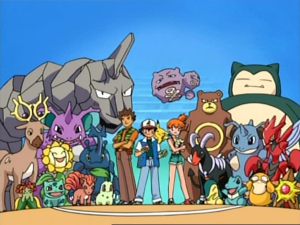 |
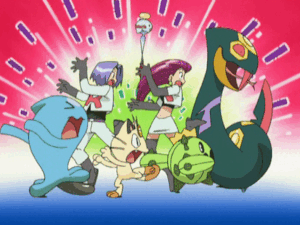 |
| This
shot, taken from the Season 4 opening "Born to be a
Winner," is one of several scenes created by OLM specifically for the
English
dub. |
Mime
Jr was digitally removed from this shot in "Unbeatable" as the
Pokémon's existence had not officially been revealed in the U.S.
at the time this season was first airing. |
Below is a list of the
opening themes used in the English dub as well as the sources for the
footage used in
the new openings. First, the 4Kids seasons:
| English
Song |
Video
Source |
| "Pokémon Theme" | Mezase Pokémon Master Episode clips |
| "Pokémon World" | The Rivals! Episode clips |
| "Pokémon Johto" | OK! Episode clips |
| "Born to be a Winner" | Mezase Pokémon Master (Whiteberry
Version) Episode clips New footage created specifically for the English version |
| "Believe in Me" | Mezase Pokémon Master (Whiteberry
Version) Ready Go! Maemuki Rocket-Dan Episode clips |
| "I Wanna be a Hero" | Advance Adventure Episode clips |
| "This Dream" | Challenger!! Episode clips |
| "Unbeatable" | Pokémon Symphonic Medley Battle Frontier Episode clips |
When TPCi took over the
company more or less followed in their predecessor's footsteps,
creating brand new songs to serve as their opening themes even though
the rest of the anime industry had
long since shifted to keeping the Japanese songs by this point.
| English
Song |
Video
Source |
| "Battle Frontier" | Spurt! Episode clips |
| "Diamond & Pearl" | Together Episode clips |
| "We Will Be Heroes" | Together Kimi no Soba de ~Hikari no Theme~ Episode clips |
| "~Battle
Cry~ (Stand Up!)" (4:3 version) (Episodes 1201-1215) |
Episode Clips |
| "~Battle
Cry~ (Stand Up!)" (16:9 version) (Episodes 1216 - 1252) |
High Touch Episode clips |
| "We Will Carry On" | Saikoh Everyday! |
| "Black & White" | Best Wishes! |
| "Rival Destinies" | Episode Clips |
| "It's Always You and Me" (Versions 1-3) | Yajirushi ni Natte! Yajirushi ni Natte! 2013 Natsumeku Sakamichi |
| "Pokémon Theme (Version XY)" | V (Volt) |
| "Be a Hero" | Mega V (Mega Volt) |
| "Stand Tall" | XY&Z |
| "Under the Alolan Sun" | Alola! Episode clips |
| "Under the Alolan Moon" | Alola! Episode clips |
| "The Challenge of Life" | Mirai Connection Kimi no Bouken |
| "The Journey Starts Today" | One, Two, Three (Version 1) Episode clips |
| "Journey to Your Heart" | One, Two, Three (Version 3) Episode clips |
| "With You" | One, Two, Three (Version 4) |
| "Gotta Catch Em All" | Mezase Pokémon Master 2023 Episode clips |
| "Becoming
Me" |
Dokimeki Diary |
The Japanese version has
been including staff credits during the opening themes since the very
beginning, but the English openings didn't start the practice until
Season 11.
| Background Music |
Like many anime dubs of the late 1990s, the English dub of Pokémon features a replacement music score.
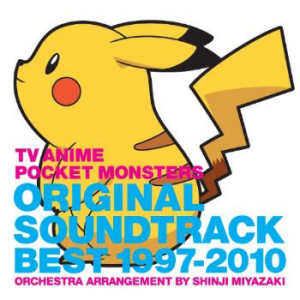 |
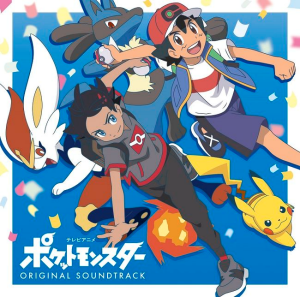 |
| A few of the CD
releases for the show's original background music. |
|
Most of the time, the music created for the English dub outright replaces music tracks that are used in the Japanese version. Now the 4Kids Pokémon dub is a bit unique in that it doesn't replace 100% of the soundtrack of a TV episode, but at the same time it doesn't ever retain 100% of it either. The number of tracks it ends up replacing varies wildly from season to season, episode to episode. Pieces of music that are kept in one episode might get removed in another, making it very difficult to determine any sort of rhyme or reason to the changes.
When the show moved over to TPCi the music replacement continued. These days the music replacement is all over the place; we've had episodes keep 100% of the Japanese music, episodes that've only kept a handful of pieces, and episodes that have kept 0% of the Japanese music. As of 2023 the Pokémon dub remains one of the few English language anime dubs currently in production to still have a replacement soundtrack.
The English dub score is also used to fill in any moments of silence. If there's a scene without any background music in the Japanese version then, 99.99% of the time, the English dub will use one of the pieces of background music in its library to help "fill the gap," as it were. Both 4Kids and TPCi seem to have this allergy to letting a single second go by without there being some music droning on in the background and so what we end up getting is a dub that's essentially wall-to-wall music.
Fans have been keeping track of how much of the Japanese soundtrack's been left in over the years and have even compiled all that data in a handy Google Doc. Pocketmonsters.net's Episode Guide also features a "Music" tab on each episode's page that lists out exactly which tracks are used in both the Japanese version and the English dub.
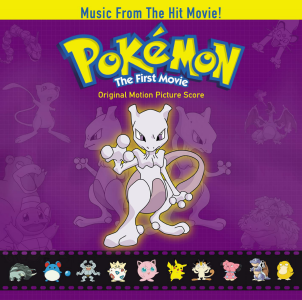 |
| CD
release for the dub's replacement soundtrack to Mewtwo Strikes Back! |
For years and years fans had their own theories as to why the music got replaced, or why 4Kids / TPCi were so darn inconsistent with it. In an interview with Michael Haigney, the show's adaptation writer from back in the 4Kids days, he states that "We replace [the music] for both artistic and commercial reasons. I don't think it's any more or less insensitive than dubbing." And 4Kids Productions president Norman Grossfeld went on record to say they replaced the background music "to better reflect what American kids would respond to." Some fans also believed the music replacement couldn't be helped, that it was necessity due to JASRAC, or because the music rights are just too expensive, but no concrete evidence to support any of these claims has ever surfaced.
But then, in 2020, Eric Stuart provided an answer that pretty much said the quiet part out loud:
| "So,
it's all about licensing. So for those of you who don't know, I
directed Yu-Gi-Oh!, I did...I directed some Pokémon, I directed
a Pokémon movie here and there. Um, so I was on both sides of
the glass for, for many many years. And one of the reasons is when
you...when they purchased the licensing of a show, right, and they
reformat it...when they license it to different countries the voices
are being replaced, right? But if the music is not being replaced then
you're making residuals on that end of it. So what 4Kids decided was
hey, we'll redo the music so that when it's airing in Canada, or it's
airing in, you know, France or Germany or whatever and they're
replacing the actors with their local actors they're still making the
money on the licensing of the music. So it's all about that, which
makes a lot of sense. Now in some of the films there might've been a deal with the Japanese company, you can't change...you can remove that song or whatever, but a lot of the movies, even in the closing credits, we might've used their music but we rewrote the lyrics. And so they own the publishing on that end of it. So it's all about that so...Or they bought the rights to it and then make money on that as well. So it's all about the money. That's how it works." |
While the practice of mixing soundtracks in this manner is rare, especially in this day and age, it's not unheard of. Other English dubs that mix soundtracks include Zatch Bell, The Prince of Tennis, MÄR, Kiki's Delivery Service, the Fox Kids Escaflowne dub, and Battle of the Planets.
| Character Names |
If Guinness World Records has a category for "most name changes in an the English language localization of a Japanese cartoon" then Pokémon would win that award no contest.
 |
 |
| In Pocket Monsters (1997) Episode 04 "The
Samurai Boy's Challenge!" you can see the main character's Japanese
name written on his sleeping bag. |
|
There are literally thousands and thousands of proper nouns in this show, and the overwhelming majority of them get changed for the English dub. A lot of these are simply carry-overs from the video games and other media and therefore couldn't be helped; if the very first Gym Leader you face is named Brock in the video games, and Brock in the trading card games, and Brock in the comics...then for consistency's sake he should be called "Brock" in the animated series as well, right?
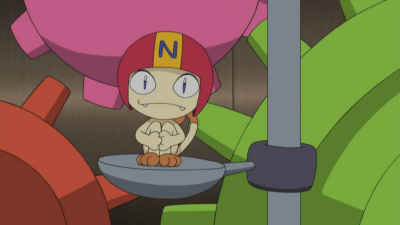 |
| In
Pocket Monsters XY Episode 127 "The Heatbursts at the Trick Festival!"
this member of the Rocket trio wears a helmet with the first letter of
his Japanese name. |
Likewise, the characters who are anime originals -- Satoshi, Shigeru, Musashi, Kojirou, and all those hundreds and hundreds of characters-of-the-days, among others -- got renamed as well. This was likely also done for consistency's sake. If the narrator of the show went "Today we join Satoshi, Misty, and Brock" then that'd actually end up raising a lot of questions not present in the original. Why does only one of these characters have a Japanese name? Is this "Satoshi" kid a foreigner? Are Brock and Misty from Kanto, but Satoshi isn't? And so on, and so on. Changing some names but then leaving others alone introduces implications that weren't really there in the original and so just about everyone in the English dub got Westernized names to match how just about everyone in the Japanese version has Japanese names.
| Pokémon Pronouns |
In the English dub, neither 4Kids nor TPCi use the pronouns "he" or "she" to refer to the show's Pokémon characters, instead opting to use the pronoun "it." In fact, The Pokémon Company International has even formalized this policy into their style guides, like this one from sometime around the Black & White era:

In Japan, meanwhile, the whole "only ever refer to Pokémon using a gender neutral pronoun" idea isn't really a thing, but that has to do with the way the language works in the first place more than anything else. While third person pronouns do indeed exist in the Japanese language (kare for he/him/his, kanojo for she/her/hers), they're almost never used in actual everyday speech. Most of the time people just repeat the proper noun ("Pikachu was given a Berry. Pikachu found the Berry to be very delicious") or omit the subject/object of the sentence altogether ("Pikachu was given a Berry; very delicious") and allow context clues to do the rest of the heavy lifting for them.
In fact you can go days, if not weeks, without using either kare or kanojo and it somehow feels perfectly natural. I went through the transcripts of the Japanese version of the original Pocket Monsters (1997) TV series, and while the very similar-sounding karera ("they") is used by the narrator a few times early on, the very first time the word kare is used by literally anyone in the Pocket Monsters animated series isn't until twenty episodes into the series (わたしもここで彼に会える日をずっと待っています). Kanojo doesn't make its debut until Episode 21 (かわいい彼女と旅立ったって).
So in Japan there's no real pronoun "rule" while in the English version everyone has to refer to (just about) every Pokémon as "it." Some fans of the English version feel it's a bit weird to refer to living creatures as "it" -- calling your best friend an "it" sounds cold and impersonal, some might say -- but I would look at it remembering that the Pokémon World is not the same world as our real world. We may balk at the idea of calling our pets "it" but who knows -- in the Pokémon world it might just be seen as the most natural thing ever!
| Eyecatches |
The English dub of Pokémon does what a lot of made-for-TV anime dubs in the late 1990s weren't doing and actually included the show's eyecatch segments!
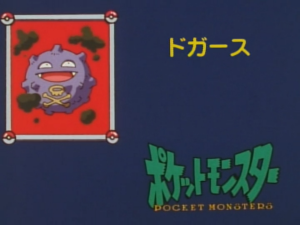 |
 |
The visuals are completely different between the two -- the simple blue background gets replaced by the most gaudy series of special effects 90s computers had to offer, and the animators' original drawings of the Pokémon get replaced by stock artwork -- and the music's replaced as well, but as far as the formatting goes it's actually pretty decent. We hear a group of kids shout out "Who's That Pokémon!" (a decent rending of the Japanese version's Da~re da!) while a silhouette's shown on the screen, and then when we get back from commercial break they reveal the Pokémon's name and its full artwork.
The eyecatches provide 4Kids/TPCi with yet another opportunity to teach its audience these characters' names (you can't ask your parents to buy you Pikachu merchandise if you don't even know its name!) so I'm sure that's the only reason they even bothered to leave them in. But it's still nice to see regardless. As mentioned above, anime dubs in the 1990s usually just cut the eyecatches from the English version and so to see Pokémon, of all dubs, leave them in is really something else.
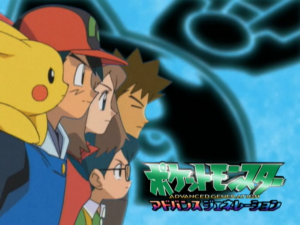 |
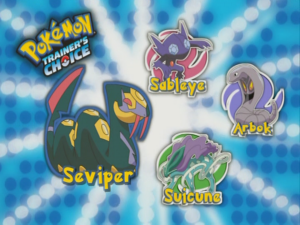 |
| The
eyecatch for the Japanese version of Pocket Monsters Advanced
Generation Episode 077 "A Formidable Enemy!? The Entrance of Mama-san
the Coordinator!" |
The
eyecatch for the English dub equivalent, Pokémon: Advanced
Challenge Episode 737 "A Fan With a Plan." |
Over the years the Japanese version would replace the "Who's That Pokémon?" eyecatches with ones featuring the show's human cast, and then re-introduce "Who's That Pokémon?", and then get rid of them again, etc. etc. The English dub, meanwhile, would go on to do its own thing. When the Japanese version got rid of "Who's That Pokémon?" in Pocket Monsters Advanced Generation, for example, the English dub equivalent of those episodes continued to use the segment regardless.
| Post-Show Music Videos |
The music videos made to promote the English dub's CDs "Pokémon 2.B.A. Master" and "Totally Pokémon" that appear at the end of every episode of the show's first three seasons are, as you might imagine, not present in the Japanese version.
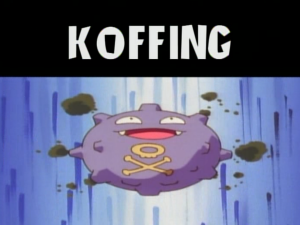 |
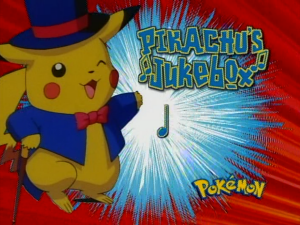 |
| These segments have no
equivalents in the
Japanese version. |
|
Starting from the English dub's fourth season these music video segments went away. While an official reason has never been revealed, their discontinuation was most likely due to a combination of 4Kids not having any more music to promote as well as broadcast networks' requirements for advertising time becoming more strict.
| Ending Credits |
In the Japanese version, the show's end credits are their own production with their own unique songs and animation. For many fans, the ending themes are just as much a part of the show's overall presentation as the opening themes are. The songs themselves vary from those sung by the show's cast, to those sung by outside artists, to those sung by popular pop groups of the day. The animation can also vary just as much; some of the ending themes have very minimal animation while others can be just as dynamic as the opening themes are.
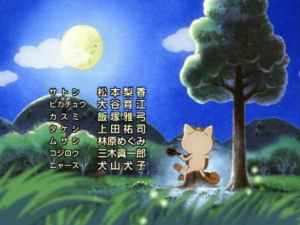 |
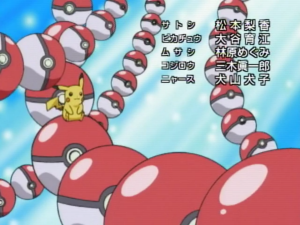 |
| Nyarth
no Uta, the second ending theme to the original Pocket Monsters series,
is sung by Inuko Inuyama in-character as Nyarth. |
Pokettaari
Monstaari, the final ending theme to the original Pocket Monsters
series, is performed not by one of the show's voice actors but by a
completely different artist instead. |
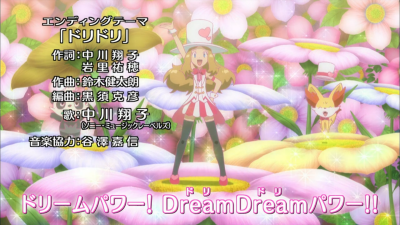 |
|
| The
"Dream Dream" ending from the XY series features animation on par with
any of the show's opening themes. |
|
Credits are written up on an episode-by-episode basis, allowing viewers to keep track of who worked on any given episode of the show. Voice actors are credited alongside the characters they voiced, key animators and in-betweeners are credited, and any insert songs that may have been used are properly credited.
In the English version, unfortunately, none of this is the case. On the music side of things, the ending theme to the English dub of the show has pretty much always just been a reprise of the show's opening theme, either copy/pasted as-is or presented as an instrumental version without lyrics. The visuals would, likewise, consist of the same visuals used for that season's opening theme, squashed and stretched to fit on the left side of the screen.
 |
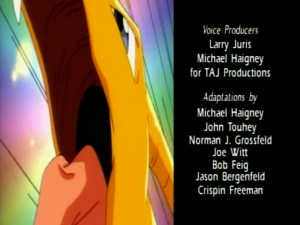 |
| Typical
ending credits sequence for Pokémon: Indigo League |
Typical
ending credits sequence for Pokémon: Adventures in the Orange
Islands. |
Footage from the Japanese ending themes was never used for the American ending themes during the 4Kids days, though it would sometimes find its way into other projects.
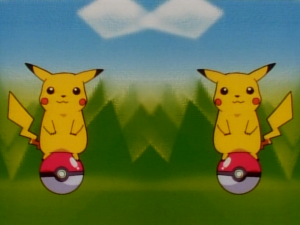 |
 |
| This
shot from the Pokérap takes footage from the Japanese version's
first ending theme, Hyaku Gojuu-Ichi, and then mirrors it to create two
Pikachu. |
This
shot of Team Rocket in the Seasons 5 / 6 opening "Believe in Me" is
taken from the Japanese ending theme Maemuki Rocket-Dan. |
During the 4Kids days a single, a single set of generic credits would be used for entire batches of episodes, making it impossible to figure out exactly who worked on any given episode. The credits back then also heavily favored the U.S. production side of things, with the Japanese staff credits being shoved all the way to the end. The artists who actually made the show, like screenplay writers, animators, or background artists were not included in the English dub credits.
Things got a lot better during the TPCi days. After a few years of plain white text against a black background, the company would actually make use of some of the footage from the Japanese ending credits, though the music used is still an instrumental of one of the show's opening themes. Credits also tend to be better now, with a lot more of the Japanese staff actually being acknowledged compared to in the past.
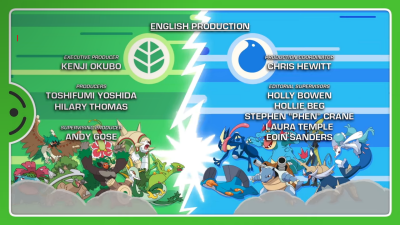 |
| The ending theme to
the Pokémon Ultimate Journeys: The Series episode "The Rainbow
and the Pokémon Master." The animation is taken from the
Japanese ending theme "Batsugun Type" while the music is the show's
opening theme "Gotta Catch Em All" |
Unfortunately, neither the 4Kids nor the TPCi dub break down which actors portray which roles the way the Japanese version does.
| Post-Show Segments |
At the end of each episode, after the end credits but before the Next Episode Preview, the Japanese version plays an approximately minute long segment as an extra little bit of content. Early itinerations of this were called Dr. Ookido's Pokémon Lecture (オーキド博士のポケモン講座) and would feature the professor highlighting a specific Pokémon each episode before being viciously attacked in a slapstick-y kind of way. The segment would end with Dr. Ookido reading a senryuu poem featuring the Pokémon's name.
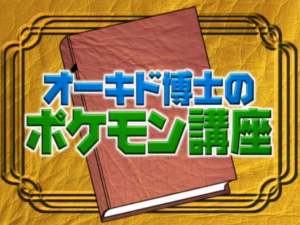 |
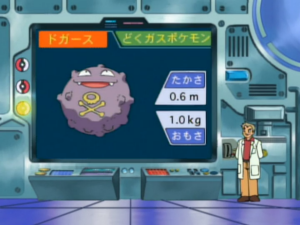 |
| The
segment's title screen. |
Dr.
Ookido provides some facts about whatever Pokémon he's featuring
that day. |
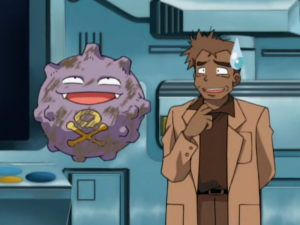 |
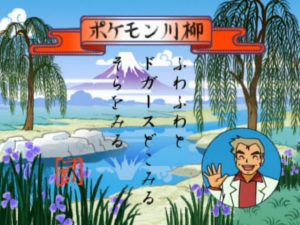 |
| The
Pokémon is brought into the lab with Dr. Ookido where they
usually use some sort of attack on the professor. |
Dr.
Ookido ends the segment by reciting a senryuu poem about the
Pokémon. |
About halfway through Pocket Monsters Advanced Generation these Dr. Ookido lecture segments were replaced by a new segment, Pokémon Trivia Quiz (ポケモントリビアクイズ). Throughout the years these end-of-episode segments have changed numerous times, sometimes several times within the same series. While Dr. Ookido getting attacked by a Pokémon makes up the bulk of these segments, other characters get to be put in charge of these segments from time to time.
| Series |
Segment |
| Pocket
Monsters (1997) |
Dr. Ookido's Pokémon Lecture (オーキド博士のポケモン講座) |
| Pocket
Monsters Advanced Generation |
Dr. Ookido's Pokémon Lecture (オーキド博士のポケモン講座) Pokémon Trivia Quiz (ポケモントリビアクイズ) |
| Pocket
Monsters Diamond & Pearl |
Dr. Ookido's Pokémon
Encyclopedia (オーキド博士のポケモン大百科) Pikachu the Movie Memorial (ピカチュウ・ザ・ムービーメモリアル) |
| Pocket
Monsters Best Wishes! Pocket Monsters Best Wishes! Season 2 Pocket Monsters Best Wishes! Season 2: Episode N Pocket Monsters Best Wishes! Da! |
Dr. Ookido's Pokémon Live Caster (オーキド博士のポケモンライブキャスター) |
| Pocket
Monsters XY Pocket Monsters XY&Z |
Dr. Ookido's Pokémon Holo Caster (オーキド博士のポケモンホロキャスター) PokéTV (ポケTV) |
| Pocket
Monsters Sun & Moon |
Pokémon Problem (ポケもんだい) |
| Pocket
Monsters (2019) |
Get Inspired! Let's Solve a Poké
Riddle! (ひらめきゲット!Let's ポケなぞ!!) The Rocket-Dan Who Stands for the Evils of Truth and Love's Expedition (愛と真実の悪を貫くロケット探検団) |
| Pocket
Monsters (2023) |
Dr.
Friede's Pokémon Seminar (フリード博士のポケモンゼミ) |
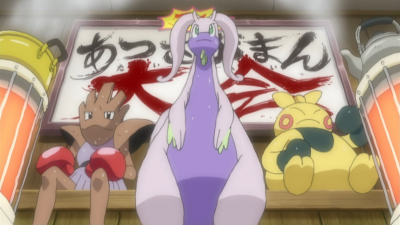 |
| Japan knows these
end-of-episode segments never get dubbed and so they allow themselves
to include things like Japanese text they usually refrain from using. |
While these segments are mostly silly standalone little gags, they do pop up in the series proper from time to time. In Pocket Monsters (1997) Episode 245 "A Fake Dr. Ookido!? The Senryuu Showdown!!" (released in the U.S. as "Will the Real Oak Please Stand Up?") we see that a version of Dr. Ookido's Pokémon Lectures exist in-universe as a radio show broadcast in the Johto region. This is something Japanese viewers would have instantly recognized as a cute reference to those post-episode segments but for English dub viewers this probably seemed like a random character quirk that comes out of nowhere.
| Next Episode Previews |
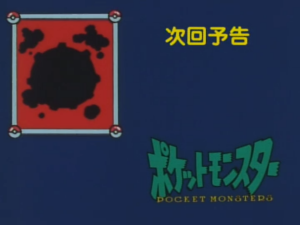 |
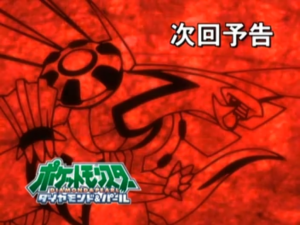 |
| The
Next Episode Preview for the second episode of Pocket Monsters (1997).
The Pokémon shown in the silhouette is the same one that'll be
the topic of the next episode's Who's That Pokémon? segment. |
The
first screen of the Next Episode Preview for the Pocket Monsters
Diamond & Pearl series. |
The previews are about 30 seconds long and show various clips from the next episode while one of the show's main characters gives a brief summary of what we can expect to see in the following week's episode. The previews are usually pretty straightforward but there are times (especially in Sun & Moon) when they're more silly and lighthearted. Next Episode Previews have their own unique music, though this is sometimes swapped out with other music from the show depending on the vibe the show's going for that particular week.
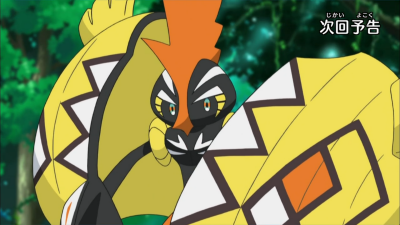 |
| In the
Next Episode Preview for Pocket Monsters Sun & Moon Episode 002
""Enter the Guardian Deity Kapu Kokeko! Let's Try Out Our Z-Move!!"
Satoshi spends most of the segment working on how to say Kapu-Kokeko's
name. |
The English dub has never included these Next Episode Previews at any point in the show's run. The various networks Pokémon's aired on (Kids' WB!, Cartoon Network, etc.) will sometimes create their own episode-specific promos but all of those have been standalone commercials and not part of the actual show itself. Neither 4Kids nor TPCi have ever dubbed the Japanese Next Episode Previews.
| Eyecatches | Post-Show Music Videos | Ending Credits | Post-Show Segments | Next Episode Previews |
Found an error or omission? Please help me keep this page current and error-free by e-mailing me with a description of the issue.

